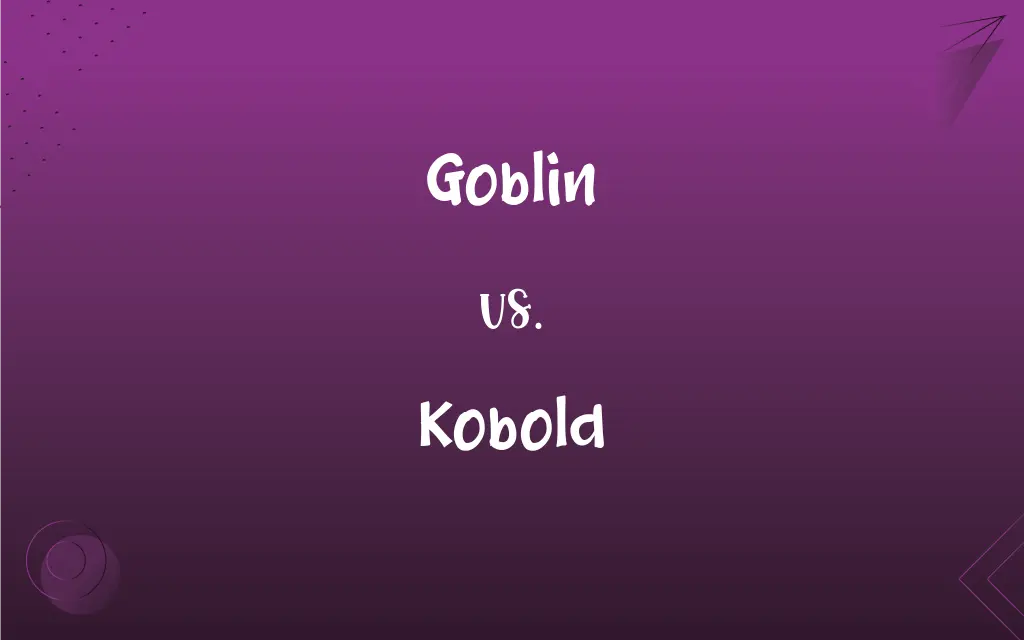Goblin vs. Kobold: What's the Difference?
By Harlon Moss || Updated on May 22, 2024
Goblin refers to a mythical creature often depicted as a small, mischievous, and grotesque being in folklore, while kobold is a mythological sprite or spirit from Germanic folklore, often associated with underground realms and mining.

Key Differences
Goblin is a term originating from European folklore, describing a small, grotesque creature known for causing trouble and mischief. Goblins are often depicted as malevolent or mischievous beings that dwell in dark places like forests, caves, or under bridges. Kobold, on the other hand, comes from Germanic folklore and represents a sprite or spirit that can be either helpful or harmful. Traditionally, kobolds are associated with the underground, particularly in mines where they can either aid miners or play malicious tricks.
While both goblins and kobolds are mythical creatures with mischievous tendencies, goblins are generally more widely recognized in popular culture, whereas kobolds are specifically tied to Germanic mythology and have a closer association with mining and subterranean environments.
Comparison Chart
Origin
European folklore
Germanic folklore
Common Depiction
Small, grotesque, mischievous creature
Sprite or spirit associated with mines
Behavior
Malevolent or mischievous
Helpful or harmful depending on context
ADVERTISEMENT
Dwelling
Dark places like forests, caves
Underground, mines, or homes
Cultural Presence
Widely recognized in popular culture
Specific to Germanic tales
Goblin and Kobold Definitions
Goblin
A mythical creature dwelling in dark places.
Goblins were believed to hide in caves, coming out at night to cause havoc.
Kobold
A sprite or spirit from Germanic folklore, often linked to mining.
The miners left offerings for the kobold to ensure a safe workday.
Goblin
A troublesome and tricky entity.
The goblin's laugh echoed through the haunted woods.
ADVERTISEMENT
Kobold
A household spirit that can be either helpful or troublesome.
The kobold would help with chores if treated kindly but played tricks if neglected.
Goblin
A small, grotesque, and mischievous creature in folklore.
The children were scared by tales of goblins lurking in the forest.
Kobold
A folklore character associated with both aid and mischief.
Kobolds were known to assist miners but could also lead them astray.
Goblin
A malevolent being causing trouble and chaos.
The goblin stole the villagers' food and played nasty tricks on them.
Kobold
A mythical being living underground.
Legends say that kobolds guard the treasures hidden deep within the earth.
Goblin
A common character in fantasy literature.
The hero had to defeat the goblins to rescue the princess.
Kobold
An often mischievous household elf in German folklore.
Goblin
A grotesque elfin creature of folklore, thought to work mischief or evil.
Kobold
A gnome that haunts underground places in German folklore.
Goblin
One of various hostile supernatural creatures, now especially (fantasy literature) a malevolent and grotesque diminutive humanoid, often associated with orcs or trolls.
Kobold
(German mythology) An ambivalent, sometimes vindictive, spirit that is capable of materialising as an object or human, often a child; a sprite.
Goblin
An evil or mischievous spirit; a playful or malicious elf; a frightful phantom; a gnome.
To whom the goblin, full of wrath, replied.
Kobold
(German folklore) A mischievous elf or goblin, or one connected (and helpful) to a family or household.
Goblin
(folklore) a small grotesque supernatural creature that makes trouble for human beings
Kobold
(fantasy literature) One of a diminutive and usually malevolent race of beings.
Kobold
A kind of domestic spirit in German mythology, corresponding to the Scottish brownie and the English Robin Goodfellow.
Kobold
A creature that can bring good or bad fortune.
The kobold's presence was believed to influence the success of the mine.
FAQs
Where are kobolds usually found?
Kobolds are often found underground in mines or within homes, performing tasks or playing tricks.
What is a goblin?
A goblin is a small, grotesque, and mischievous creature from European folklore, often depicted as causing trouble and chaos.
What is a kobold?
A kobold is a sprite or spirit from Germanic folklore, commonly associated with mines and household tasks, and can be either helpful or harmful.
Can kobolds be friendly?
Yes, kobolds can be friendly and helpful, especially in tales where they assist miners or household members.
What are common traits of kobolds?
Common traits of kobolds include being small, sprite-like, associated with the underground or household tasks, and having variable behavior.
Where do goblins usually live?
Goblins typically live in dark places such as forests, caves, or under bridges.
Are goblins always malevolent?
Goblins are generally portrayed as malevolent or mischievous, though their behavior can vary in different stories.
How are goblins depicted in modern media?
In modern media, goblins are often depicted as tricky, dangerous creatures that heroes must outwit or defeat.
Do goblins have a specific role in folklore?
Goblins often serve as antagonists in folklore, causing trouble for humans and requiring cleverness to defeat or escape.
What are common traits of goblins?
Common traits of goblins include being small, ugly, mischievous, and often malevolent.
Are kobolds considered good or bad?
Kobolds can be either good or bad, depending on how they are treated and the context of their story.
How are kobolds depicted in fantasy games?
In fantasy games, kobolds are typically small, reptilian humanoids that dwell in caves and mines, often as low-level adversaries.
Can goblins be friendly?
While traditionally malevolent, some modern interpretations depict goblins as more neutral or even friendly under certain circumstances.
How do goblins impact human lives in folklore?
Goblins impact human lives by causing mischief, stealing, and creating chaos, often requiring heroes to intervene.
Are goblins part of any specific cultural mythology?
Goblins are part of various European mythologies and folklore traditions, prominently featuring in stories from the British Isles.
Do kobolds have a specific role in Germanic tales?
Kobolds play the role of household spirits or mine guardians, capable of both aiding and hindering human efforts.
How do kobolds impact human lives in folklore?
Kobolds impact human lives by either assisting with tasks or causing trouble, depending on how they are treated.
Are kobolds part of any specific cultural mythology?
Kobolds are specific to Germanic mythology and folklore, particularly in regions like Germany and Scandinavia.
Do goblins appear in modern literature?
Yes, goblins appear frequently in modern literature, especially in fantasy genres like J.R.R. Tolkien's works and the Harry Potter series.
Do kobolds appear in modern literature?
Yes, kobolds appear in modern literature and fantasy games, often as creatures in stories involving mining or underground adventures.
About Author
Written by
Harlon MossHarlon is a seasoned quality moderator and accomplished content writer for Difference Wiki. An alumnus of the prestigious University of California, he earned his degree in Computer Science. Leveraging his academic background, Harlon brings a meticulous and informed perspective to his work, ensuring content accuracy and excellence.































































